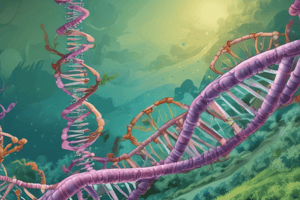Podcast
Questions and Answers
What is the primary purpose of the polymerase chain reaction (PCR)?
What is the primary purpose of the polymerase chain reaction (PCR)?
- To sequence entire genomes.
- To analyze the entire genetic code.
- To replicate specific segments of DNA. (correct)
- To separate DNA fragments of varying sizes.
Which of the following steps is NOT involved in the basic process of PCR?
Which of the following steps is NOT involved in the basic process of PCR?
- Denaturation
- Annealing
- Gel electrophoresis (correct)
- Extension
Why is short tandem repeat (STR) profiling preferred over the older restriction enzyme method?
Why is short tandem repeat (STR) profiling preferred over the older restriction enzyme method?
- It amplifies target sequences without restriction enzymes. (correct)
- It creates longer DNA fragments.
- It relies on manual analysis rather than automation.
- It requires more DNA samples.
In the context of DNA analysis, what does a DNA profile or fingerprint represent?
In the context of DNA analysis, what does a DNA profile or fingerprint represent?
What role do fluorescent labels play in modern DNA sequencing?
What role do fluorescent labels play in modern DNA sequencing?
What characteristic differentiates homozygotes from heterozygotes in the context of STR profiling?
What characteristic differentiates homozygotes from heterozygotes in the context of STR profiling?
What advancement in DNA sequencing technology was noted since its early manual methods?
What advancement in DNA sequencing technology was noted since its early manual methods?
What is the primary purpose of genetic engineering in biotechnology?
What is the primary purpose of genetic engineering in biotechnology?
What is a genetically modified organism (GMO)?
What is a genetically modified organism (GMO)?
Which enzyme is responsible for cutting DNA at specific sequences in recombinant DNA technology?
Which enzyme is responsible for cutting DNA at specific sequences in recombinant DNA technology?
What role do sticky ends play in recombinant DNA technology?
What role do sticky ends play in recombinant DNA technology?
What is the function of DNA ligase in recombinant DNA technology?
What is the function of DNA ligase in recombinant DNA technology?
Which statement correctly describes DNA sequencing?
Which statement correctly describes DNA sequencing?
What characteristic differentiates a transgenic organism from other GMOs?
What characteristic differentiates a transgenic organism from other GMOs?
Why is the knowledge of DNA and RNA function crucial for genetic engineering?
Why is the knowledge of DNA and RNA function crucial for genetic engineering?
Flashcards are hidden until you start studying
Study Notes
Biotechnology
- The use of natural biological systems to create a product or achieve a desired outcome.
Genetic Engineering
- Modifying genomes of organisms, including bacteria, plants, and animals
- Goal: improve organism characteristics or create biotechnology products
- Enabled by decades of advancements in DNA and RNA research
Recombinant DNA (rDNA)
- Contains genes from two or more different sources
- Requires a vector (carrier for foreign DNA), commonly a plasmid (accessory ring of DNA in bacteria cells)
- Uses restriction enzymes to cut DNA at specific sequences
- DNA ligase seals foreign DNA into a cut plasmid
- "Sticky ends" facilitate the insertion of foreign DNA into vector DNA
DNA Sequencing
- Determines the order of nucleotides in a DNA segment
- Used to identify specific disease-related alleles, leading to medicine and treatment development
- Applied in forensic biology and evolutionary history studies
- Early methods involved manual procedures with dye-terminator substances or radioactive tracers
- Modern methods utilize dye-attached nucleotides detected by lasers in automated sequencing machines
Polymerase Chain Reaction (PCR)
- Creates billions of copies of a DNA segment in a test tube
- Amplifies a specific DNA target sequence, generally hundreds of bases long
- Uses DNA polymerase and nucleotides for replication
- Involves repeated cycles of three basic steps: denaturation, annealing, and elongation
DNA Analysis
- Advanced from using restriction enzymes to fragment the entire genome to short tandem repeat (STR) profiling
- STR profiling is more efficient and uses PCR to amplify fluorescently labeled target DNA sequences
- Automated DNA sequencers separate fragments by length, with a corresponding variation in the number of STRs at a specific locus
- Individuals with homozygous STRs have one fragment, while heterozygotes have two fragments with different lengths
Studying That Suits You
Use AI to generate personalized quizzes and flashcards to suit your learning preferences.




